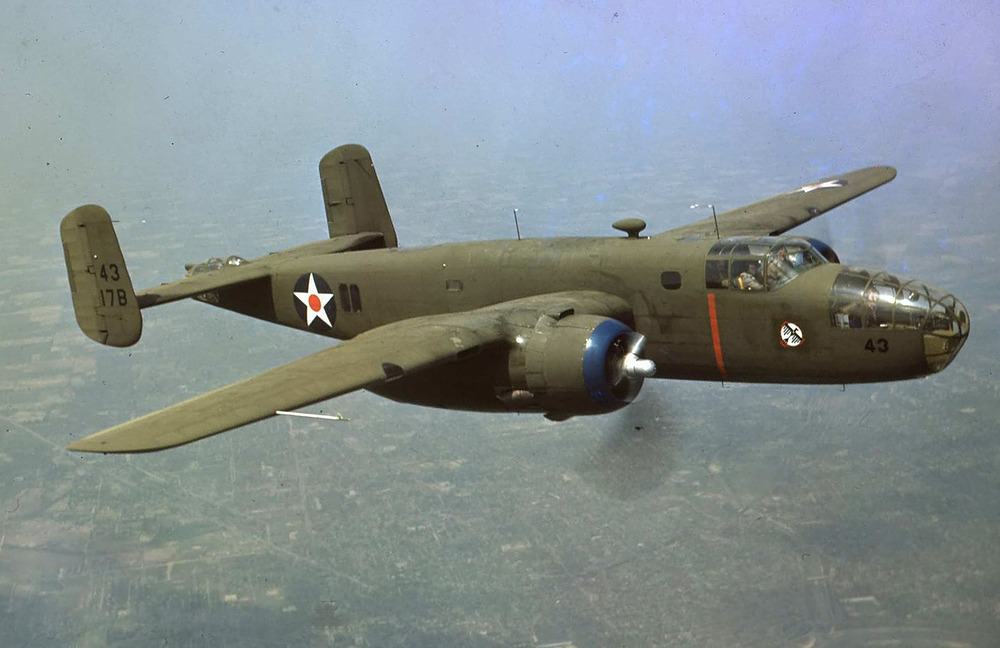Would you like to see this in-game?
North American B-25A Mitchell
Hello everybody. I’d like to suggest the North American B-25A Mitchell for the US aviation tree in War Thunder. This early model was an improved version of the initial production B-25-NA, incorporating self-sealing fuel tanks and armor protection for the crew to improve survivability. Its defensive armament was still relatively weak, as it lacked a dorsal turret. A total of 40 B-25As were built and delivered during 1941, making them the first Mitchell variant declared combat-ready.
History
Following the delivery of 24 B-25-NAs in 1941, the B-25A was developed in response to combat reports from Europe. The original B-25-NA had no self-sealing fuel tanks and minimal armor, making it unsuitable for missions over enemy territory where it would face heavily armed fighters and increasingly capable anti-aircraft fire. To address these shortcomings, the US Army Air Corps required the addition of both self-sealing tanks and crew armor for the new B-25A.
North American implemented these changes beginning with the 25th aircraft on the production line. A 3/8-inch armor plate was installed behind the pilot’s, copilot’s, and bombardier’s seats, as well as in the gunner’s compartments. The self-sealing fuel tanks reduced maximum fuel capacity by 246 gallons, from 913 to 694 gallons, cutting operational range by approximately 750 miles. The added armor and tank weight increased maximum gross weight by 210 pounds, slightly degrading performance: top speed dropped from 322 mph to 315 mph, service ceiling fell from 30,000 ft to 27,000 ft, and rate of climb worsened. These losses were considered acceptable given the substantial increase in crew protection.
Forty B-25As were built before production switched to the B-25B, which introduced power-operated turrets. The B-25A equipped the 17th Bombardment Group (Medium) at McChord Field, already familiar with the B-25-NA, and also served with the 30th Bombardment Group in New Orleans, the 43rd Bombardment Group in Bangor, Maine, the 39th Bombardment Group in Spokane, Washington, and the 44th Bombardment Group at MacDill Field, Florida. To compensate for reduced range, a 418-gallon drop tank could be carried in the bomb bay during ferry flights or long patrols.
Although the B-25A was considered combat-ready, the US entered the war just as the turret-equipped B-25B became available. As a result, no B-25As saw overseas combat. Instead, they were used for anti-submarine patrols along the US coasts, over both the Pacific and Atlantic Oceans, as well as the Gulf of Mexico. In these roles, B-25As carried the bomb bay drop tank and were fitted with underwing racks for bombs or depth charges. The 17th Bombardment Squadron was credited with sinking an enemy submarine off both coasts. By 1942, the B-25A was declared obsolete and redesignated RB-25A.
Specifications
North American B-25A Mitchell
Number Built: 40
General Characteristics
Crew: 1 (Pilot, copilot, bombardier, navigator/radio operator, and gunner)
Dimensions:
Length: 54 ft 1 in (16.48 m)
Height: 15 ft 9 in (4.80 m)
Wingspan: 67 ft 6.75 in (20.59 m)
Wing Area: 610 sq ft (56.67 sq m)
Propeller:
Type: 2 x 3-blade Hamilton Standard
Diameter: 12 ft 7 in (3.84 m)
Powerplant:
Type: 2 x Wright Cyclone R-2600-9 air-cooled radials
Power Output:
1,700 hp (1,268 kW) each @ takeoff (3,400 hp/2,536 kW total)
1,350 hp (1,007 kW) each @ 13,000 ft (3,962 m) (2,700 hp/2,014 kW total)
Fuel Capacity: 694 US gal (2,627 L) self-sealing tanks
Weight:
Empty: 17,870 lb (8,105 kg)
Gross: 25,322 lb (11,486 kg)
Max. Takeoff: 27,100 lb (12,292 kg)
Flight Performance
Power-to-Weight Ratio: 0.13 hp/lb (0.22 kW/kg)
Max Speed: 315 mph (507 km/h) @ 15,000 ft (4,572 m)
Wing Loading: 41.5 lb/sq ft (202.6 kg/sq m)
Climb Performance:
Rate of Climb: 1,785 ft/min (9.07 m/s)
Time to Altitude: 8.4 min to 15,000 ft (4,572 m)
Service Ceiling: 27,000 ft (8,230 m)
Range: 1,350 miles (2,170 km)
with 694 gallons of fuel and a 3,000-pound bombload.
Armament
Turrets:
Nose: 1 x 0.30-in (7.62 mm) M1919 Browning (interchangeable between 3 positions)
Waist: 1 x 0.30-in M1919 Browning on each side
Ventral Tunnel: 1 x 0.30-in M1919 Browning
Tail: 1 x 0.50-in (12.7 mm) M2 Browning
Bombs:
Drawings
Related Suggestions
Mitchell Family:
British Mitchell Family (made by @lxtav ):
Sources
Thank you for taking the time to read my suggestion! 😃
4 Likes
Yes please! A +1 from me. It would be nice to have this thing at Rank II, maybe group it with the B-25B or B-25C if those ever come.
2 Likes
Most likely around 2.7 to 3.0, give or take. The B-25B/C/D would fit perfectly at 3.3.







